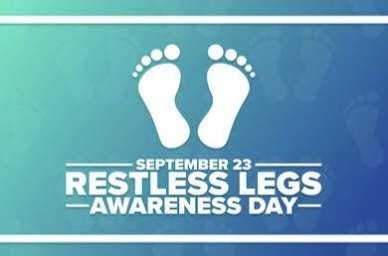Restless Legs Awareness Day – September 23, 2022, history significance why we celebrate
Restless Legs Awareness Day is observed every year on September 23 to raise awareness of this medical condition or syndrome. Willis-Ekbom Disease is a lifelong neurological condition characterized by an insatiable desire to move the legs in order to relieve unpleasant sensations such as creeping,
crawling, pulling, itching, tingling, or burning sensations. According to the National Institutes of Health, symptoms typically appear in the late afternoon or evening hours and are often most severe at night. Restless legs syndrome affects approximately 12 million people in the United States.
History of Restless Legs Awareness Day

The origin and history of Restless Legs Awareness Day date back to the year 1945. However, the Restless Legs Syndrome (RLS) has a long history. The date is precisely chosen to honor the Swedish neurologist Professor Karl-Axel Ekborn’s birthday who made the detailed study of RLS. It is characterized by a strong urge to move the legs which will usually be accompanied or caused by uncomfortable, unpleasant sensations in the legs even when at rest.
It can even occur in the arms sometimes. Restless Legs Syndrome occurs when at rest and makes it hard for the patient to sleep. Thus the syndrome results in daytime sleepiness, low energy, irritation, and a depressed mood. The treatment of this syndrome includes changes in lifestyle and medication. The observance of the day is to promote awareness among the people about the symptoms and how to treat it.
the first medical description of this rls was given by sir thomas willis in the year 1672. early nineteenth-century has termed it as fidgets in the legs. almost after three centuries after willis, karl-axel ekbom in 1945 had provided a detailed and comprehensive report about this syndrome. ekbom was the one who had coined the term “restless legs” which implies the clinical study of the hitherto overlooked disease.
throughout his career, he continued to describe the essential diagnostic symptoms, differential diagnosis from other conditions, prevalence, relation to anemia, and other common occurrences during pregnancy. rls is termed as willis-ekbom disease as it jointly acknowledges the first known description given by sir thomas willis in 1672 and the first detailed clinical description given by dr. karl axel ekbom in 1945.
RESTLESS LEGS AWARENESS DAY TIMELINE
1672
First Discovery
Sir Thomas Willis is the first to describe restless legs syndrome.
1763
Found in French Literature
More interesting accounts of possible RLS are discovered in old French literature by Boissier de Sauvages, who wrote about ‘Anxietas tibiarum’ and argued that the description met the current RLS criteria.
1945
First Detailed Description
Swedish neurologist Karl-Axel Ekbom describes this disease in detail in his doctoral thesis.
2013
Observation Day Proclaimed
North Carolina declares that Restless Legs Awareness Day be observed by all citizens.
RECOMMEND STORIES
- 10 Delicious Weight Loss Meal Plans to Kickstart Your Health Journey
- Australia team for ICC World Cup 2023 | list of players, fixtures
- Indian Team for ICC World Cup 2023 | list of all players, fixtures
- A Glorious Journey: ODI Cricket World Cup Winners (1975-2023)
- National Hair Day – October 1, 2023, history, timeline, facts
HOW TO OBSERVE RESTLESS LEGS AWARENESS DAY
Research and learn more about restless legs syndrome
You can start your day by knowing more about restless legs syndrome so that you can help raise awareness. You may even be able to assist someone who has it but is unaware that it is a real sickness with a real name.
Donate
Another fantastic way to commemorate this day is to consider giving to assist in finding a treatment, as there is currently no known working cure for the illness. (Please conduct your own research before donating!).
Visit a doctor
Consult a doctor if restless legs syndrome is interfering with your daily life. Share the therapies that have proven to be the most effective for you. You can also utilize the day to get a leg massage or do some light exercise.
5 SURPRISING FACTS ABOUT RESTLESS LEGS SYNDROME YOU NEVER KNEW
It can be linked to iron deficiency
The relationship between low iron and restless legs has been extensively researched. According to research, persons who suffer from restless legs have lower-than-normal iron levels.
Your veins may be to blame
Many patients’ restless legs have been traced back to underlying venous problems, according to their doctors. Fortunately, a recent study indicated that non-surgical vein therapy helped 98 percent of individuals suffering from varicose veins.
Its risk can be increased by pregnancy
Restless leg syndrome affects about one-third of pregnant women, and symptoms are most likely to emerge during the last three months of pregnancy. Although the precise reason is unknown, doctors suspect it is related to low folate and iron levels.
Genetics plays a factor
Restless legs syndrome is a syndrome that frequently runs in families, with 40 to 90 percent of people affected having at least one close family member with the same condition. The early-onset variant (before the age of 45) is more typically hereditary than the late-onset version (symptoms after age 45).
It can be caused by nerve damage
A nerve system illness known as peripheral neuropathy can contribute to the development of restless leg syndrome. The disorder is frequently caused by nerve damage caused by an injury, infection, illness, or diabetes.
WHY RESTLESS LEGS AWARENESS DAY IS IMPORTANT
Start young
The majority of advance care planning research involves persons over the age of 65. There is now a tendency toward involving and training much younger individuals in order to better prepare them to deal with difficulties in their homes and communities.
Help to understand family history
If both parents have restless legs, their children are more likely to have them as well: According to new research, family history is a substantial risk factor for the condition. This is encouraging news because a child’s family history can assist pave the way to a correct diagnosis. Furthermore, researchers are revealing genetic risk factors for restless legs syndrome, which could pave the way for future study and treatment.
To create early awareness for early treatments
The day has been designated to educate the general public about this neurologic and sleep-related movement disease. This is to raise people’s awareness so that they can seek medical attention as soon as possible.








